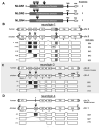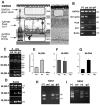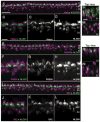Alternative splicing of neuroligin and its protein distribution in the outer plexiform layer of the chicken retina
- PMID: 21031560
- PMCID: PMC4065168
- DOI: 10.1002/cne.22499
Alternative splicing of neuroligin and its protein distribution in the outer plexiform layer of the chicken retina
Abstract
Although synaptogenesis within the retina is obviously essential for vision, mechanisms responsible for the initiation and maintenance of retinal synapses are poorly understood. In addition to its scientific interest, understanding retinal synapse formation is becoming clinically relevant with ongoing efforts to develop transplantation-based approaches for the treatment of retinal degenerative disease. To extend our understanding, we have focused on the chick model system and have studied the neuroligin family of neuronal adhesion factors that has been shown to participate in synapse assembly in the brain. We identified chicken orthologs of neuroligins 1, -3, and -4, but could find no evidence of neuroligin 2. We investigated temporal and spatial patterns of mRNA and protein expression during development using standard polymerase chain reaction (RT-PCR), quantitative PCR (QPCR), laser-capture microdissection (LCM), and confocal microscopy. At the mRNA level, neuroligins were detected at the earliest period tested, embryonic day (ED)5, which precedes the period of inner retina synaptogenesis. Significant alternative splicing was observed through development. While neuroligin gene products were generally detected in the inner retina, low levels of neuroligin 1 mRNA were also detected in the photoreceptor layer. Neuroligin 3 and -4 transcripts, on the other hand, were only detected in the inner retina. At retinal synapses neuroligin 1 protein was detected in the inner plexiform layer, but its highest levels were detected in the outer plexiform layer on the tips of horizontal cell dendrites. This work lays the groundwork for future studies on the functional roles of the neuroligins within the retina.
© 2010 Wiley-Liss, Inc.
Figures











Similar articles
-
Molecular dynamics of photoreceptor synapse formation in the developing chick retina.J Comp Neurol. 2008 Feb 10;506(5):822-37. doi: 10.1002/cne.21582. J Comp Neurol. 2008. PMID: 18076030
-
Expression patterns of neurexin-1 and neuroligins in brain and retina of the chick embryo: Neuroligin-3 is absent in retina.Neurosci Lett. 2006 Mar 6;395(2):114-7. doi: 10.1016/j.neulet.2005.10.076. Epub 2005 Nov 21. Neurosci Lett. 2006. PMID: 16300891
-
Unique versus Redundant Functions of Neuroligin Genes in Shaping Excitatory and Inhibitory Synapse Properties.J Neurosci. 2017 Jul 19;37(29):6816-6836. doi: 10.1523/JNEUROSCI.0125-17.2017. Epub 2017 Jun 12. J Neurosci. 2017. PMID: 28607166 Free PMC article.
-
A matter of balance: role of neurexin and neuroligin at the synapse.Neurochem Res. 2013 Jun;38(6):1174-89. doi: 10.1007/s11064-013-1029-9. Epub 2013 Apr 5. Neurochem Res. 2013. PMID: 23559421 Review.
-
Neuroligins, synapse balance and neuropsychiatric disorders.Pharmacol Rep. 2014 Oct;66(5):830-5. doi: 10.1016/j.pharep.2014.04.011. Epub 2014 May 9. Pharmacol Rep. 2014. PMID: 25149987 Review.
Cited by
-
Transcriptome Profiling of Embryonic Retinal Pigment Epithelium Reprogramming.Genes (Basel). 2021 May 29;12(6):840. doi: 10.3390/genes12060840. Genes (Basel). 2021. PMID: 34072522 Free PMC article.
-
Of Humans and Gerbils- Independent Diversification of Neuroligin-4 Into X- and Y-Specific Genes in Primates and Rodents.Front Mol Neurosci. 2022 Mar 30;15:838262. doi: 10.3389/fnmol.2022.838262. eCollection 2022. Front Mol Neurosci. 2022. PMID: 35431802 Free PMC article.
-
Structural organization and function of mouse photoreceptor ribbon synapses involve the immunoglobulin protein synaptic cell adhesion molecule 1.J Comp Neurol. 2014 Mar;522(4):900-20. doi: 10.1002/cne.23452. J Comp Neurol. 2014. PMID: 23982969 Free PMC article.
-
Alternative splicing at neuroligin site A regulates glycan interaction and synaptogenic activity.Elife. 2020 Sep 11;9:e58668. doi: 10.7554/eLife.58668. Elife. 2020. PMID: 32915137 Free PMC article.
-
RIT2, a neuron-specific small guanosine triphosphatase, is expressed in retinal neuronal cells and its promoter is modulated by the POU4 transcription factors.Mol Vis. 2013 Jun 17;19:1371-86. Print 2013. Mol Vis. 2013. PMID: 23805044 Free PMC article.
References
-
- Aartsen WM, Arsanto JP, Chauvin JP, Vos RM, Versteeg I, Cardozo BN, Bivic AL, Wijnholds J. PSD95beta regulates plasma membrane Ca2+ pump localization at the photoreceptor synapse. Mol Cell Neurosci. 2009;41:156–165. - PubMed
-
- Adler R. Curing blindness with stem cells: hope, reality, and challenges. Adv Exp Med Biol. 2008;613:3–20. - PubMed
Publication types
MeSH terms
Substances
Grants and funding
LinkOut - more resources
Full Text Sources
Molecular Biology Databases

